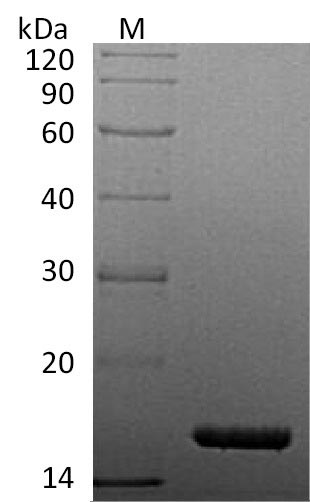Recombinant Human Tumor Necrosis Factor (TNF) is produced in E. coli and includes a C-terminal 6xHis tag. This partially expressed protein corresponds to amino acids 77-233 and achieves a high purity of over 95% as determined by SDS-PAGE analysis. It demonstrates biological activity with an ED50 of 10-40 pg/ml in a cytotoxicity assay using L929 mouse fibroblast cells. The endotoxin level is maintained below 1.0 EU/µg, verified by the LAL method.
TNF appears to be one of the most critical cytokines involved in systemic inflammation and serves as part of the body's immune response. The protein plays what seems to be a key role in regulating immune cells and inducing apoptotic cell death, inflammation, and inhibition of tumorigenesis. Given its central position in inflammatory processes, TNF has become an important molecule in the study of inflammatory diseases and cancer research. This makes it a valuable target for therapeutic interventions, though the complexity of its signaling pathways may present challenges.
Potential Applications
Note: The applications listed below are based on what we know about this protein's biological functions, published research, and experience from experts in the field. However, we haven't fully tested all of these applications ourselves yet. We'd recommend running some preliminary tests first to make sure they work for your specific research goals.
1. Cytotoxicity Assays for TNF Pathway Research
This recombinant human TNF is highly biologically active (ED₅₀ 10-40 pg/ml in L-929 cells) and suitable for cytotoxicity studies. However, the partial sequence (77-233aa) represents the soluble TNF form rather than full-length transmembrane TNF, which may affect some biological functions. The C-terminal His-tag is unlikely to significantly impact cytotoxicity assays, but researchers should validate that cell death mechanisms (apoptosis vs. necroptosis) match those induced by full-length TNF in their specific cell models. The exceptional potency requires careful dose optimization.
2. Anti-TNF Antibody Development and Validation
This TNF serves as a good antigen, but antibodies generated against this partial sequence may not recognize epitopes in the missing N-terminal region (aa 1-76). The C-terminal His-tag may induce tag-specific antibodies. Comprehensive validation should include testing against full-length TNF to ensure recognition of all functional domains. The high bioactivity supports the development of neutralizing antibodies, but epitope coverage may be incomplete.
3. TNF Receptor Binding Studies
The protein is appropriate for receptor binding studies, but the partial sequence and C-terminal tag may alter binding kinetics compared to full-length TNF. While the demonstrated cytotoxicity confirms TNFR1 engagement, researchers should validate binding affinity for both TNFR1 and TNFR2 using full-length TNF as a reference. The tag may facilitate immobilization, but could affect measurements if receptors interact with the C-terminal region.
4. Inflammatory Response Modeling in Cell Culture
The protein is suitable for inflammation studies, but the soluble form (77-233aa) may not fully replicate membrane-bound TNF's functions in cell-cell signaling. Researchers should validate that NF-κB activation, cytokine production, and other inflammatory responses match those induced by full-length TNF, particularly regarding signaling amplitude and duration. The low endotoxin ensures specific attribution of effects.
5. Drug Screening and Inhibitor Development
The highly active TNF is excellent for inhibitor screening, but the partial structure may affect compound binding if inhibitors target the missing N-terminal domain. Hits should be validated against full-length TNF to ensure relevance to physiological TNF inhibition. The extreme potency allows low-concentration screening but requires precise dosing to avoid false negatives.
Final Recommendation & Action Plan
This E. coli-expressed partial human TNF (77-233aa) with a C-terminal His-tag is an exceptionally potent tool for TNF research, but its truncated nature (representing soluble TNF rather than full-length transmembrane TNF) requires specific validation. For immediate use: employ at very low concentrations (10-100 pg/ml) based on the ED₅₀, but establish dose-response curves for each specific application as potency may vary across cell types. The partial sequence corresponds to natural soluble TNF, making it suitable for studying systemic TNF effects, but researchers studying membrane-bound TNF functions should validate key findings with full-length TNF. For antibody development, this protein is adequate for generating antibodies against soluble TNF epitopes, but comprehensive coverage requires full-length TNF. For drug screening, the high potency enables sensitive assays, but prioritize validation of hits against full-length TNF. The E. coli expression produces a non-glycosylated protein, but as TNF is not glycosylated, this is not a concern. Always include appropriate controls (e.g., vehicle, tag-only) and consider that different TNF receptors (TNFR1 vs TNFR2) may exhibit varying sensitivity to this soluble TNF form compared to membrane-bound TNF.




